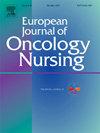Multidimensional fatigue and its predictive factors in patients with radiation-induced brain injury after radiotherapy for nasopharyngeal carcinoma: A cross-sectional study
IF 2.7
3区 医学
Q1 NURSING
引用次数: 0
Abstract
Purpose
To investigate and compare the multidimensional fatigue between nasopharyngeal carcinoma (NPC) patients with radiation-induced brain injury (RBI) and without RBI after radiotherapy, and further explore the predictive factors in NPC patients with RBI.
Methods
This prospective study included 135 NPC patients with RBI and 135 group matched NPC patients without RBI from June 2023 to October 2023 in Guangzhou, China. The patients were asked to complete paper questionnaires by themselves, including socio-demographic characteristics, anxiety, depression, sleep quality, and multidimensional fatigue with five dimensions: general fatigue, mental fatigue, physical fatigue, reduced activity, and reduced motivation, while their cognitive function were assessed by professionals. NPC patients without RBI completed questionnaires about socio-demographic characteristics and multidimensional fatigue on their own.
Results
The total fatigue and all dimensions of fatigue in NPC patients with RBI were comparably increased than NPC patients without RBI. There were significant differences between two groups in total fatigue and three dimensions, including general fatigue, physical fatigue and reduced activity (p < 0.05). In NPC patients with RBI, the predictive factors of five dimensions were different. Employment status, coexisting cardiovascular disease, coexisting endocrine disease, anxiety, depression, PSQI subjective sleep quality dimension, and cognitive function were significant predictors of the total fatigue, accounting for 44.10% of the total variance [F(p) = 16.102 (<0.001)].
Conclusions
Our data demonstrated that fatigue showed more severe in all dimensions in NPC patients with RBI compared to NPC patients without RBI, with significant differences in total fatigue and three dimensions, general fatigue, physical fatigue, reduced activity.
求助全文
约1分钟内获得全文
求助全文
来源期刊
CiteScore
4.40
自引率
3.60%
发文量
109
审稿时长
57 days
期刊介绍:
The European Journal of Oncology Nursing is an international journal which publishes research of direct relevance to patient care, nurse education, management and policy development. EJON is proud to be the official journal of the European Oncology Nursing Society.
The journal publishes the following types of papers:
• Original research articles
• Review articles

 求助内容:
求助内容: 应助结果提醒方式:
应助结果提醒方式:


